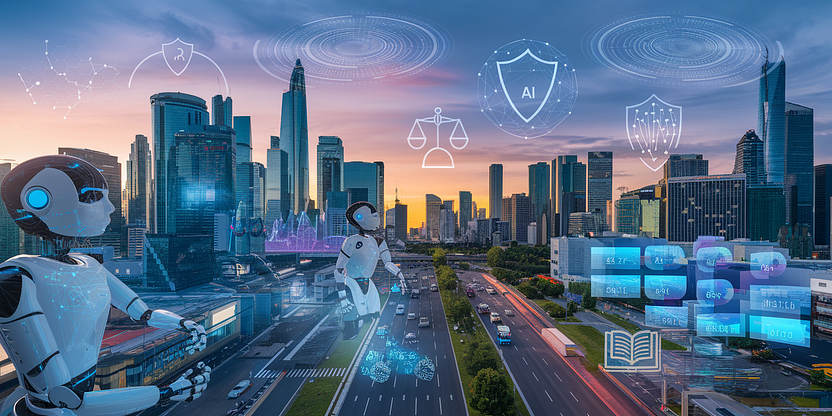
AI Checklist: Machine Learning, Ethics & Applications (2025)
Introduction
As artificial intelligence (AI) continues to evolve, navigating the complex landscape of machine learning, ethics, and applications becomes crucial. Whether you are a developer, business leader, or enthusiast, understanding these key elements will aid in making informed decisions. This 2025 AI checklist provides you with the essential categories and considerations you need to thrive in the AI landscape.
The Complete Checklist
[ ] Machine Learning Algorithms
Why This Matters:
Selecting the right algorithms impacts efficiency and effectiveness.
What To Look For:
- Compatibility with your data size and complexity
- Scalability across different platforms
- Availability of community support and documentation
Recommended Products:
Budget Option: Scikit-learn ($0)
Ideal for beginners, lacks advanced features
Best Value: TensorFlow ($0)
Comprehensive library, recommended for intermediate users
Premium: SAS Viya ($XX)
Robust commercial solution, suitable for enterprise applications
Common Mistake: Overcommitting to a single algorithm—diversify your strategy by testing different algorithms.
[ ] Data Ethics
Why This Matters:
Ethical AI development builds trust and accountability.
What To Look For:
- Transparent data handling processes
- Compliance with privacy laws
- Ethical impact assessments
Recommended Products:
Budget Option: Open Ethics Toolkit (Free)
Provides basic frameworks, lacks comprehensive guidelines
Best Value: IBM's AI Fairness 360 (Free)
Well-supported toolkit with extensive documentation
Premium: DataEthx Solutions ($XX)
Customized ethical audits for large enterprises
Common Mistake: Ignoring ethical guidelines—prioritize consistent ethical reviews.
[ ] AI Applications
Why This Matters:
Understanding applications helps leverage AI's full potential.
What To Look For:
- Applicability to your industry
- Integration capabilities with existing systems
- ROI potential
Recommended Products:
Budget Option: AutoML by Google Cloud (Pay-as-you-go)
Accessible for all business sizes, costs add up
Best Value: IBM Watson Products (Varies)
Broad application suite with strong customer support
Premium: Salesforce Einstein AI ($XX)
Full-featured CRM integration, high initial cost
Common Mistake: Mismatched applications—align solutions with your strategic goals to maximize effectiveness.
[ ] AI Platforms
Why This Matters:
Platforms streamline development and deployment processes.
What To Look For:
- Ease of use and integration
- Support for multiple languages
- Cloud versus on-premise options
Recommended Products:
Budget Option: Google Colab (Free)
Basic tier offers limited resources
Best Value: Microsoft Azure AI (Pay-as-you-go)
Strong support and integration features
Premium: AWS SageMaker ($XX)
Feature-rich, preferred for complex deployments
Common Mistake: Overlooking platform compatibility—ensure chosen platforms support your existing tech stack.
[ ] AI Training Programs
Why This Matters:
Quality education empowers better solutions and career growth.
What To Look For:
- Accreditation and industry recognition
- Flexibility in learning formats
- Community and alumni engagement
Recommended Products:
Budget Option: Coursera AI Courses (Varies)
Affordable, self-paced
Best Value: Udacity AI Nano Degrees ($XX)
Industry partnerships, balanced cost-value
Premium: MIT Professional Education ($XX)
Prestigious but costly
Common Mistake: Choosing programs that are too broad—focus on specializations that match your career goals.
[ ] AI Hardware
Why This Matters:
The right hardware enhances processing power and efficiency.
What To Look For:
- Processing speed, at least 3.1 GHz
- GPU capabilities, minimum of 8GB
- Energy consumption levels
Recommended Products:
Budget Option: NVIDIA Jetson Nano ($99)
Entry-level, limited processing power
Best Value: NVIDIA RTX 3070 ($499)
Solid performance, fair price
Premium: NVIDIA Tesla V100 ($XX)
Best for research and intensive tasks
Common Mistake: Undersized hardware—consider future scalability when choosing hardware.
Budget Summary
Category Budget Best Value Premium ML Algorithms $0 $0 $XX Data Ethics Free Free $XX AI Applications Pay-as-you-go Varies $XX AI Platforms Free Pay-as-you-go $XX AI Training Programs Varies $XX $XX AI Hardware $99 $499 $XXFAQ
Q: How do I choose the right AI platform?
A: Evaluate based on integration ease, language support, and whether cloud or on-premise solutions are better for your needs.
Q: Can I balance ethics with profitability in AI applications?
A: Yes, prioritize ethical reviews and ensure compliance with legal standards to build trust and long-term sustainability.
Q: Why is hardware important for AI development?
A: The right hardware accelerates processing, allowing for efficient management of complex tasks and models.
Q: What are essential features of AI training programs?
A: Look for accredited programs with flexibility and strong industry recognition that align with your specific goals.
Q: How can I ensure I'm using the right AI applications for my industry?
A: Focus on applications aligned with strategic goals and consult industry case studies for best practices.
Final Checklist (Quick Reference)
- [ ] Machine Learning Algorithms
- [ ] Data Ethics
- [ ] AI Applications
- [ ] AI Platforms
- [ ] AI Training Programs
- [ ] AI Hardware
 Checklist Method
Checklist Method



